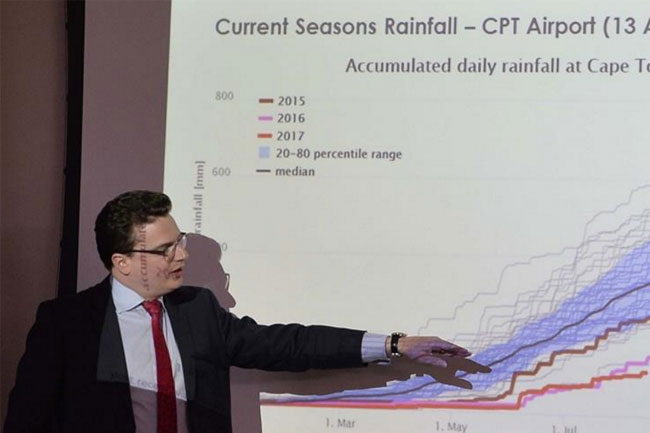Today journalists gathered to hear the much-anticipated ‘water resilience plan’ which was unveiled by the Mayor of the City of Cape Town.
We’ve gathered a collection of tweets and media which were tweeted today during proceedings, to provide an accurate picture of what the plan will be going forward.
Journalists gather to hear the Mayor speak on @CityofCT water resilience plan #thinkwater pic.twitter.com/CKT87NxJFS
— Priya Reddy (@Priyared) August 17, 2017
The drought we are experiencing is the most stubborn, intense and protracted in recent history says @PatriciaDeLille #ThinkWaterCT pic.twitter.com/c4pXgI3sBu
— Priya Reddy (@Priyared) August 17, 2017
If we didn’t manage the water crisis, we would have run out of water long ago says @PatriciaDeLille #ThinkWaterCT
— Priya Reddy (@Priyared) August 17, 2017
We will not implement water shedding. We will manage our water supply effectively. #ThinkWaterCT
— Patricia de Lille (@PatriciaDeLille) August 17, 2017
Stad Kaapstad se 4-jaar historiese damvlakke. #waterresilience #thinkwaterCT pic.twitter.com/6I40ooGQ1S
— James Styan (@jamesstyan) August 17, 2017
.@CapeTownCRO shows the @CityofCT‘s plan to get additional 500ML of new water a day: groundwater, desalination & water reuse. #ThinkWaterCT pic.twitter.com/M3f5WKsoBE
— Patricia de Lille (@PatriciaDeLille) August 17, 2017
.@CapeTownCRO says @CityofCT envisage to spend R2bn on capital projects in current & next fin years & R1.3bn operating costs to supply water pic.twitter.com/LnwhNOMklZ
— Patricia de Lille (@PatriciaDeLille) August 17, 2017
To summarize, the City aims to get an additional 500 million litres of water into the City daily, by means of desalination, groundwater extraction, and water re-use. The breakdown has been laid out as follows:
| Technology | Total Ml/day per technology | Locations |
| Immediate and first tranche | ||
| Groundwater extraction | 100 | Atlantis and Silverstroom, Cape Flats, Cape Peninsula, Hottentots Holland |
| Desalination – land-based containers | 50 | Koeberg, Silverstroom, Woodbridge Island, Granger Bay, Hout Bay, Red Hill, Strandfontein, Monwabisi, Harmony Park |
| Desalination – barge | 50 | Cape Town Harbour |
| Second trenche | ||
| Water reuse | 50 | Zandvliet Wastewater Treatment Works, Bellville Wastewater Treatment Works, Fisantekraal Wastewater Treatment Works, Potsdam Wastewater Treatment Works, Cape Flats Wastewater Treatment Works, Macassar Wastewater Treatment Works |
| Desalination – land-based permanent | 50 | Cape Town Harbour |
| Extreme Trenche | ||
| Desalination – marine-based | 200 | Cape Town Harbour Gordons Bay |
| Total | 500 | |
To quote the statement released by the City, there is additionally a planned augmentation of 10 Ml/day from the TMG aquifer and 1 Ml/day from the Oranjezicht Spring. Both these initiatives featured in the drought response prior to the launch of the Water Resilience Portfolio Response in May.
The City’s Chief Resilience Officer (CRO) forecasts that up to R2 billion rand will be spent on capital projects during the current and next financial year, while an amount of R1.3 billion has been projected as the operating costs to supply this water.
Quoting the City further, the conclusion was that ‘there are numerous other initiatives related to household and business adaptation that are under way which will be announced in due course. The strategic phase includes a number of initiatives, such as improving efficiencies in the Western Cape Water Supply System, rehabilitation of catchments outside of Cape Town’s jurisdiction, and improved management and use of stormwater. The water resilience approach has both short- and long-term ambitions.’
We’ll keep you posted with further updates.
Photography City of Cape Town






